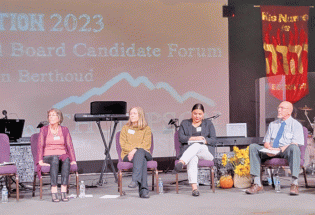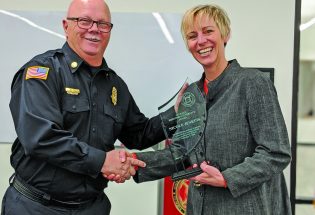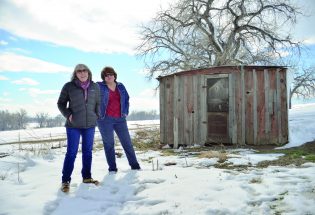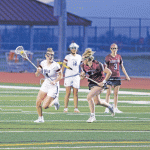Polar vortex collapse brings a freezing February to Berthoud
Welcome back to another Berthoud Weather Nerd column! After a pretty quiet January for weather events, February came around to shake things up with a super chilly Valentine’s weekend. So cold in fact that it tied the previous record low temperature in Denver for February 14th set in 1903 with a freezing low of -10 on the Sunday morning.
I’m sure you’ve heard plenty of references to the infamous ‘polar-vortex’ by now, and I’ve even discussed its influence on Berthoud’s own weather patterns before, but I wanted to take a closer look at just how it can send us such a sudden freezing arctic blast and what triggers this kind of event.
As I’ve mentioned previously, I myself am underqualified but overly enthusiastic when it comes to the science of weather. This doesn’t stop my curiosity though and can often lead to hours of research when wanting to understand some recent phenomenon so I can break it down into something a bit more accessible. This is what I’d love to share with you today.
Despite its recent trending in news stories and on social media, the polar vortex isn’t something new, it’s actually a feature of our weather that’s always been around. Put in its most simple form the polar vortex is a large area of low pressure and cold air surrounding both of the Earth’s poles. It always exists near the poles, but weakens in summer and strengthens in winter.
What’s more interesting (to weather nerds at least) is that there are not one but two polar vortexes in each hemisphere, North and South. One exists in the lowest layer of the atmosphere, the troposphere, which is where we live and where the weather happens. The other exists in the second-lowest, called the stratosphere. This all might sound like just a bit too much detail but it’s useful to understand, especially when it comes to explaining the recent freezing weather.
The lower tropospheric polar vortex is the one that affects our weather. The best explanation I’ve heard is to imagine it as a backyard full of dogs, and the jet stream around it is a fence. The dogs are always trying to escape through gaps in the fence. Occasionally a few of them manage to get out and cause a few days of very cold weather. But once in a while, the entire fence collapses, and almost all of the dogs run wild. That is when the big cold-air outbreaks happen.
The top layer of the polar vortex, in the stratosphere, doesn’t normally have much impact on our weather and spends most of its time swirling away, pretty disconnected from the layer below. Once in a while though, the stratospheric vortex gets disrupted by something called a Sudden Stratospheric Warming event. When this happens, the vortex can actually split (otherwise known as a collapse) and affect the weather below it.
A major Sudden Stratospheric Warming event took place on January 5th of this year and was the beginning of the weather pattern we are just seeing now. The warming wave crawled over the entire North Pole in the stratosphere, effectively splitting the cold-core of the polar vortex into two parts. One over North America and one over Europe. This disruption caused the jet stream (or fence) to kink and bend, releasing a chunk of the vortex our way giving us the extreme cold dip we witnessed.
So that gives us the why of the cold event but not the how. If you’re like me you want to know what causes the Sudden Stratospheric Warming event in the first place? It’s estimated they happen around six times each decade and, as with a lot of patterns in nature, there are competing theories as to why. Most scientists do seem to agree that the sudden warming in the stratosphere starts much closer to the ground, in the troposphere, and in order for this abrupt disruption to reach upward, you need the excess energy of an extreme weather pattern.
The high heat and drought that we witnessed in 2020 would definitely seem to fit into this theory, providing enough energy to disrupt the vortex so much that North America and Europe have witnessed some of the coldest weather for years.
The upside to understanding these patterns is that even though Bethoud saw some of its coldest temperatures for four years, the meteorologists were able to give us quite a bit of warning. This hopefully led to more time for preparations to get vulnerable people and animals out of the cold.
It may be a little while until we see a weather dip that extreme again but I’m sure the local weather will find other ways to keep us on our toes this year.
- October, 19 2023

Thompson School Board candidate forum...
Courtesy photoCandidates for the Thompson School District Board of Education answered...
- July, 26 2020

Greatly anticipated TPC Colorado club...
Photos by AMber McIver-Traywick - A grand entryway with large stone fire place leads to...
- November, 02 2018

Community Foundation of Northern Colo...
Special to the Surveyor Community Foundation of Northern Colorado awards $35,850 to projects in Berthoud...
- February, 24 2020

Work on the I-25 Bridge will shut dow...
Detour sign with arrow pointing to right Special to the Surveyor The I-25 North Express...
- March, 21 2020

Berthoud fire honors Nicole Jenkins w...
Special to the Surveyor The Berthoud Fire Protection District would like to share with your...
- March, 31 2016

Preserving the family farm
Larimer County purchases Malchow Farm for $8.4 million in innovative deal ...

POLICEBLOTTER
Community News
Northern Water sets C-BT quota at 70% for 2024
Community News

Emotions run high during Revere Property hearing
Community News
Snowpack at 119% above normal
Community News

Karspeck to serve third term as Berthoud mayor
Community News

OPINION – No bitchin’ allowed
Community News
Roy Tripi to become principal of BHS on July 1
Community News
COMMUNITY CALENDAR:
Community Calendar – add an event
Homestead Fine Art Gallery First Fridays OPEN HOUSE
03 May 4:00 PM - 7:00 PM
Homestead Fine Art Gallery First Fridays OPEN HOUSE
07 Jun 4:00 PM - 7:00 PM
Homestead Fine Art Gallery First Fridays OPEN HOUSE
05 Jul 4:00 PM - 7:00 PM
Homestead Fine Art Gallery First Fridays OPEN HOUSE
02 Aug 4:00 PM - 7:00 PM
Homestead Fine Art Gallery First Fridays OPEN HOUSE
06 Sep 4:00 PM - 7:00 PM
Homestead Fine Art Gallery First Fridays OPEN HOUSE
04 Oct 4:00 PM - 7:00 PM

